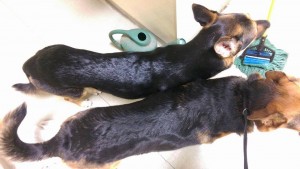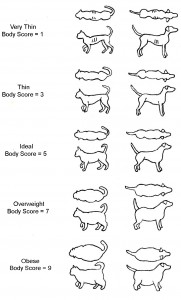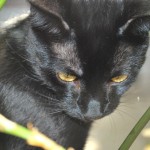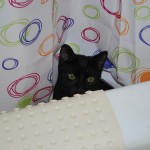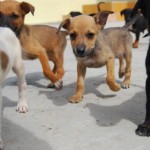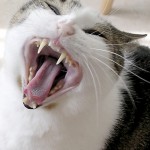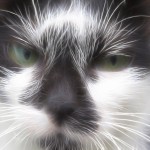Better Foods, Better Pets
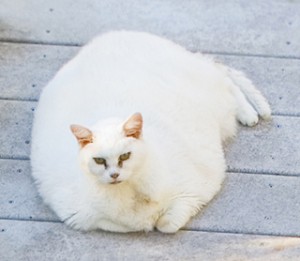 I hope the photo of the large white cat to the left is photo-shopped. If not, this poor cat’s excessive weight will result in a miserable life due to limited mobility, a higher risk of cancer, diabetes, arthritis, and a shortened life span.
I hope the photo of the large white cat to the left is photo-shopped. If not, this poor cat’s excessive weight will result in a miserable life due to limited mobility, a higher risk of cancer, diabetes, arthritis, and a shortened life span.
Data collected by the Banefield Pet Hospital from over 800 animal hospitals from across the country have revealed that 40% of American cats and dogs are overweight or obese. Within five years, this has been a jump of 37% in dogs, and a 90% rise for cats. In this study, owners who were interviewed about how they felt about their pet being overweight, 76% of dog owners and 69% of cat owners said they felt fine about it (Ref: Live Science, October 2013).
According to the CDC website, the percentage of (human) US adults who are overweight, including obesity, is 69%. Well, you have to ask yourself: “If they don’t care about their own weight, why would they care about their pets weight?” (I should add: It doesn’t mean only overweight humans have overweight pets. I’ve seen plenty of slender people with fat cats & dogs).
This is unfortunate, because fat is not an innate tissue. It is a highly active tissue that is involved in the release of several hormones: Such as, leptin and resistan. Also, fat houses inflammatory cyotokines, like TNFa, Interleukins 1B, & 6, & C reaction protein. And, all of this creates a persistant low grade inflammation. And, chronic inflammations lead to osteroarthritis, cardio vascular disease, diabetes, etc. In the same aforementioned Bandfield study, it is reported that between 2006 to 2010 there has been a 32% rise of diabetes in dogs, and a 16% rise in cats.
Obesity is associated with oxidative stress, and oxidative stress has a major impact on the central nervous system, and also, aging of the cat and dog. Even moderately overweight pets have early morbidity. So don’t think a few pounds isn’t going to do any harm.
The brains of aged dogs accumulate oxidative damage to proteins and lipids, which may lead to dysfunction of neuronal cells. The production of free radicals, and the lack of increase in compensatory anti-oxidant enzymes, may lead to detrimental modifications to important macro-molecules within neurons. By reducing oxidative stress through the feeding of food containing antioxidative ingredients will significantly improve, or slow down the decline of learning and memory of senior dogs. Also, recent studies has shown oxidative stress is a key factor in the progression of Chronic Kidney Disease
But, how do cats and dogs get overweight? The obvious answer is: A very bad diet.
The culprit: Well, for starters, carbohydrates and starches. And this culprit is often found in kibbles and in canned pet food. But, homemade diets can be just as guilty when certain vegetables and grains are added (And, yes. Rice is a grain).
Cats and dogs are carnivores. Therefore, they both have very little nutritional need for carbohydrates and starches. Plus, they don’t possess the digestive enzyme, amaylase, in their saliva to break down carbs/starches (herbivores and omnivores DO have amaylase in their saliva. For these animals, digestion begins in the mouth. Whereas, with carnivores, digestion begins in the stomach). However, carnivores do have amaylase in the pancreas. Also, cats and dogs don’t have cellulase to break down and digest sugars.
NOTE: As of 2019, a new study has suggested that the dog does produce a little bit of amaylase in the saliva (see study). But that doesn’t mean the dog is now an omnivore. What happens in the mouth is only a small part of what happens in a dog’s digestive system. Still, other studies have shown that the dog has absolutely no nutritional need for carbohydrates.
In nature, carnivores consume less than approximately 3% carbohydrates in their diet (to accommodate the accidental consumption of predigested stomach contents of prey animals, or the occasional medicinal herb). So, the amalyase in the pancreas is designed to handle only that small load. But imagine eating 40%-50% carbohydrates everyday, which is exactly what happens when you feed kibbles. The poor pancreas would explode (Well, not really explode. But, the unremitting stress on their metabolic system may result in pancreatitis or diabetes)
Most people think of carbohydrates as energy food. However, carnivores are built to receive their energy from protein and fats. The consumption of protein and fats evolved to signal to the animal to stop eating when its stomach is full. Eating carbohydrates doesn’t have this effect, so the animal will overeat and become obese. Carb-laden foods causes repeated surges of insulin in the body. According to a report titled The Biologically Appropriate Food Concept and the Dietary Needs of Dogs and Cats, the authors state, “Today’s high carbohydrate pet foods lead to blood sugar fluctuations, insulin resistance, and are widely considered as a leading cause of obesity, diabetes and a host of other health problems in cats and dogs.”
NOTE: Interestingly, you won’t see carbs listed on the nutritional analysis on the side of a can/box of pet food. First, it’s not required by law to do so, and, second, I’m sure it’s left off on purpose.
Consider that there are eight hormones that raise blood sugar, yet only one that lowers it. From this, we can conclude that nature saw a great deal of importance to keeping blood sugar held up to a minimum safe level, and relatively little need to lower blood sugar. This one blood lowering hormone, insulin, was invented, so to speak, to capture the rare or occasional spike in blood sugar and save it as fat. In this regard, insulin served a critical role in our evolution, and as we know, insulin is very proficient at this assignment. The hormone insulin is identical, to the last molecule, in all mammals, and does the exact same thing in all creatures. ~ Richard S. Patton
In Chinese Medicine, starches are considered “dampening,” and “damp” conditions can create an overgrowth of candida/yeast and mucus/phlegm. This is where the gooky, itchy ears and other skin conditions can become a problem for your pet.
Can You Tell If Your Cat or Dog Is Fat?
Many folks are so used to seeing fat cats and dogs that they have forgotten what they’re supposed to really look like…long and lean with a definitive waistline….yes! That’s right, a waistline.
When I show people the photo of the two dogs to the right, I’ll ask for comments. Most will say the dog on the top is too skinny, and the dog on the bottom is just right. Nope! Wrong answers.
It’s the dog on the top that has the ideal weight. The dog on the bottom is overweight. Surprised?
When was the last time you weighed your cat or dog? At the last vet visit? Do you know how much your cat should weigh? An average size female cat should weigh between 5 to 7 pounds, and an average male cat between 8 to 10 pounds. Of course, bigger breeds of cats, like Maine Coons or Bengals, may be two or three pounds more for each gender, but not much more than that.
Dogs come in more different shapes or sizes, so determining their correct weight is going to depend on the breed. But, in my opinion, the best way to know if a dog or cat is at their ideal weight is to look at the animal!
The illustration to the left is the Body Condition Score (I’ve seen a similar chart on the back of a box of kibbles, which is pretty ironic, considering it’s dry food that causes weight problems in pets). The Body Condition Score is supposed to give pet owners a visual reference as to whether their pet is at the correct weight or not.
So, stand over your cat or dog and look down. Do you see an indentation at the waistline? Or, is it straight? If it’s straight, then the animal is overweight.
Now, lets do a second test. You should be able to feel the ribcage, but not see it. There should be only a “just right” layer of fat over the ribs. The way you tell if the layer is “just right” and not too thin or too thick, try this: Put your left hand out straight and use your right hand to run your fingers over the knuckles on your left hand. That’s what the animal’s ribcage is supposed to feel like. Next, make a fist with your left hand and now run your right-hand fingers over your knuckles. It shouldn’t feel like that, the animal is too thin.
Other Problems
There are other reasons a pet may become overweight, such as, hypothyroidism. This is a condition that mostly afflicts dogs (cats are more prone to hyperthyroidism). Hypothyroidism is a disorder in which the thyroid glands are underactive and don’t secrete enough thyroid hormone. The condition can be caused by hereditary, exposure to toxins, some medications, like steroids, vaccines, a lack of exercise, and too early spay & neuter. The symptoms are, lack of energy, low tolerance for the cold, slow heart beat, hair loss, chronic infections, and weight gain without an increase in appetite.
For Further Reading: PET WEIGHT TRANSLATOR
